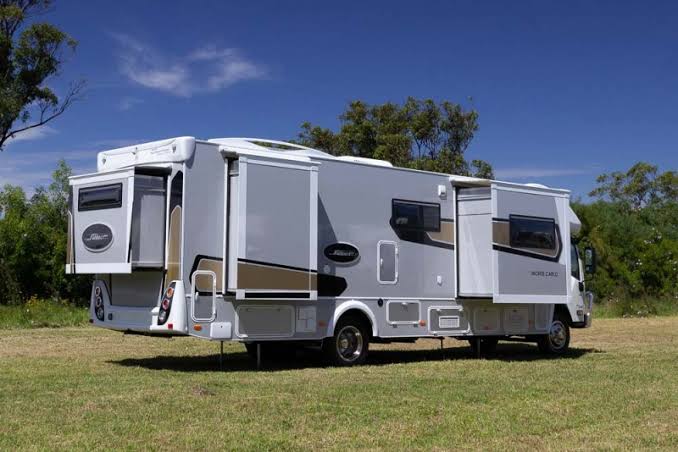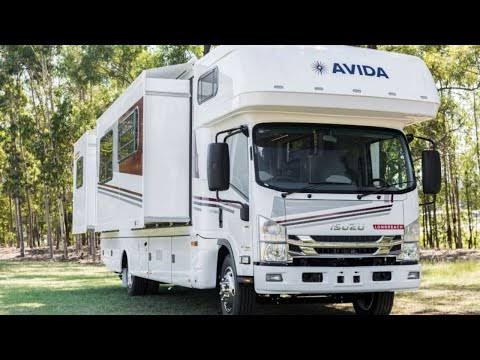- Good Sam Community
- Groups
- Motorhome Group
- Forum
- Re: Slideouts on a ClassC: How many?
- Subscribe to RSS Feed
- Mark Topic as New
- Mark Topic as Read
- Float this Topic for Current User
- Bookmark
- Subscribe
- Mute
- Printer Friendly Page
Slideouts on a ClassC: How many?
- Mark as New
- Bookmark
- Subscribe
- Mute
- Subscribe to RSS Feed
- Permalink
- Report Inappropriate Content
Apr-07-2023 02:36 AM
 Interesting here Slideouts are common on Motorhomes but not Caravans in Australia. What do you find is an iptimum number and type?
Interesting here Slideouts are common on Motorhomes but not Caravans in Australia. What do you find is an iptimum number and type?



- Labels:
-
Class C
- Mark as New
- Bookmark
- Subscribe
- Mute
- Subscribe to RSS Feed
- Permalink
- Report Inappropriate Content
Jul-05-2023 07:26 PM
Good advise. Overloading is playing Russian roulette.
My unit came with overloaded tires--but NOT overloaded axles.
I solved that by changing the wheels to a taller tire. The end result was that fully loaded I had 850 less than the maximum for the driver's rear axle. 14500 is the rating. That was with all tanks totally full and provisioned for a trip including 2 passengers. My no slides RV is 29'5". 176" E-450
It yielded 2 more inches in height, and improved the fuel mileage.
The reason for the lower pressure on the front tires was not for comfort--but rather for safe driving. At 80 psi it felt as if I were driving on a balloon. I had to keep correcting. I decided on 65 psi after weighing off front, back and each "corner".
My ride is a 28 foot Class C, 256 watts solar, 556 amp-hours of Telcom jars, 3000 watt Magnum hybrid inverter, Sola Basic Autoformer, Microair Easy Start.
- Mark as New
- Bookmark
- Subscribe
- Mute
- Subscribe to RSS Feed
- Permalink
- Report Inappropriate Content
Jul-05-2023 01:43 PM
pianotuna wrote:
Chum lee,
That is why my front wheels are at 65 psi and the rear at 80 psi
Hi Don. If those pressures soften the ride and improve the handling, I totally understand/appreciate that.
My ride: A 30' Class A F-53 178" wheelbase chassis (no slides) which is rated at 18,000 lbs. GVWR (11,000 rear and 7,000 front) with actual running weight of 16,560 lbs. It weighs approx. 10,360 rear and 6,200 front. This is fully loaded with all my stuff, +-70 gallons of fuel, +-20 gallons of propane, +-80 gallons of fresh water. The black/grey tanks empty. I like that. I run all my 19.5" tires at 90 psi. As an aging engineer and pilot, I like playing well below the established maximum limits. Years ago, I remember my Flight Instructor telling me, "There are old pilots, and there are bold pilots, but, there are no old bolt pilots." One of my favorite Engineering Professors also told me, "If you design a bridge that fails, it's best that you be on it, or, under it when it does. IMO, Stockton Rush is a recent perfect example of what they were talking about. DON'T OVERLOAD THINGS!
If you need a bigger motor home, buy one.
Chum lee
- Mark as New
- Bookmark
- Subscribe
- Mute
- Subscribe to RSS Feed
- Permalink
- Report Inappropriate Content
Jul-04-2023 09:35 PM
All my tanks except fuel, are on the driver's side. Exception is propane just behind passenger side front wheel. The house batteries are also on the driver's side.
To try to compensate, I offset the generator from the middle to as far to the passenger's side as possible.
My ride is a 28 foot Class C, 256 watts solar, 556 amp-hours of Telcom jars, 3000 watt Magnum hybrid inverter, Sola Basic Autoformer, Microair Easy Start.
- Mark as New
- Bookmark
- Subscribe
- Mute
- Subscribe to RSS Feed
- Permalink
- Report Inappropriate Content
Jul-04-2023 12:13 PM
I run about 75 PSI in the rear tires and about 65 PSI in the front tires. Even with all that weight in the rear, I still had to install Koni variable-rate shocks back there to reduce the pounding from the E450's relatively stiff rear leaf springs. (Many/most short Class C motorhomes are built on the E350 chassis.)
- Mark as New
- Bookmark
- Subscribe
- Mute
- Subscribe to RSS Feed
- Permalink
- Report Inappropriate Content
Jul-03-2023 08:31 PM
That is why my front wheels are at 65 psi and the rear at 80 psi
My ride is a 28 foot Class C, 256 watts solar, 556 amp-hours of Telcom jars, 3000 watt Magnum hybrid inverter, Sola Basic Autoformer, Microair Easy Start.
- Mark as New
- Bookmark
- Subscribe
- Mute
- Subscribe to RSS Feed
- Permalink
- Report Inappropriate Content
Jul-03-2023 11:10 AM
I know it's an extreme case, but, think about this. If you added enough people standing on your rear bumper, at some point, you could actually lift the front wheels/axle off the ground through leverage. Front wheels without enough weight on them don't tend to steer or brake well, especially in rain and snow.
Motor home manufacturers are supposed to understand this when a vehicle is in the design phase, but, IMO, sometimes they clearly don't. What drives out the factory door isn't what the initial designers intended. They sell well though!
Chum lee
- Mark as New
- Bookmark
- Subscribe
- Mute
- Subscribe to RSS Feed
- Permalink
- Report Inappropriate Content
Jul-03-2023 09:39 AM
I drew this up a few years ago to illustrate the situation with my own rig without a slide-out. On trips with a full tank of fresh water (that is located against the rear bumper) and us sitting in the front seats, the leverage from water-weight is so influential, that the measured weight on the front axle is only 100 pounds heavier during trips as compared to the rig completely empty. During trips, we load our rear axle to the rated limit as defined by Ford. Not carrying water changes the scenario significantly. We carry a full tank of fresh water because we exclusively boondock.

Adding a 500 pound slide-out located behind the rear axle on our particular rig would be detrimental.
More recently I made some suspension changes up front to address the harsh ride and rear-end sag. I replaced the heavy duty front springs with ones rated the next step down. This leveled the rig nicely and also makes the ride much better with reduced thrashing. You can read all about the project which includes pictures, by CLICKING HERE.
- Mark as New
- Bookmark
- Subscribe
- Mute
- Subscribe to RSS Feed
- Permalink
- Report Inappropriate Content
Jul-03-2023 07:42 AM
2018 Wrangler JLU - pulling duty as a daily and toad
2012 Audi A7 - daily fun car
- Mark as New
- Bookmark
- Subscribe
- Mute
- Subscribe to RSS Feed
- Permalink
- Report Inappropriate Content
Jul-02-2023 07:11 AM
Like jacks, in my travels I have seen numerous people who were "dead in the water" because they can't get one or more of the slides to retract just prior to departure from a campground in the middle of nowhere. But hey, slides are a popular option. Whatever floats yer boat.
Chum lee
- Mark as New
- Bookmark
- Subscribe
- Mute
- Subscribe to RSS Feed
- Permalink
- Report Inappropriate Content
Jul-02-2023 06:15 AM
Grit dog wrote:Then I must be one funny guy like fourthclassC.fourthclassC wrote:Hahaha that’s funny!
Personally, I would never have an RV with any slide outs. My feeling is that they detract from the structural in integrity of a vehicle going down the road. Also I don't spend that much time inside the vehicle when camping so no need for the addtional space. Again, just my feeling.
- Mark as New
- Bookmark
- Subscribe
- Mute
- Subscribe to RSS Feed
- Permalink
- Report Inappropriate Content
Jul-02-2023 04:38 AM
- Mark as New
- Bookmark
- Subscribe
- Mute
- Subscribe to RSS Feed
- Permalink
- Report Inappropriate Content
Jul-01-2023 10:48 AM
fourthclassC wrote:
Personally, I would never have an RV with any slide outs. My feeling is that they detract from the structural in integrity of a vehicle going down the road. Also I don't spend that much time inside the vehicle when camping so no need for the addtional space. Again, just my feeling.
Hahaha that’s funny!
2017 Heartland Torque T29 - Sold.
Couple of Arctic Fox TCs - Sold
- Mark as New
- Bookmark
- Subscribe
- Mute
- Subscribe to RSS Feed
- Permalink
- Report Inappropriate Content
Jun-30-2023 09:32 PM
We special-ordered our 2007 Phoenix Cruiser without a slide-out. Needless to say, our 16 year old rig has never had slide-out problems. It is a very quiet & tight rig that stays warm in the cold, and cool in the heat.
Pending the size of a slide-out, it can weight between 400 and 700 pounds. 3 large slide-outs can add near 2000 pounds to an already over-loaded USA class-C.
- Mark as New
- Bookmark
- Subscribe
- Mute
- Subscribe to RSS Feed
- Permalink
- Report Inappropriate Content
Apr-13-2023 07:54 PM
pnichols wrote:
We looked for about a year for a used Class C - before we unexpectedly found and bought a new 2005 Class C in early 2006.
We searched so long because of our list of requirements ... which the new 2005 one we bought in 2006 by pure luck ... just happened to satisfy. Since then I've always guessed that probably the new one we bought had sat on a dealer's lot unsold for one year because it DID NOT have slides!
We did not want slides for improved off-road reliability and overall ruggedness. Years before we had traveled around in remote desert areas in our 3/4 ton Dodge van home-built camper ... and in 2006 bought a Class C that could do the same.
Mine sat on the lot from 2005 to 2009--same reason no slides. I love it.
My ride is a 28 foot Class C, 256 watts solar, 556 amp-hours of Telcom jars, 3000 watt Magnum hybrid inverter, Sola Basic Autoformer, Microair Easy Start.





